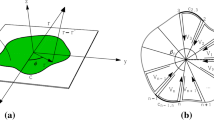Abstract
The computation of the lead field of a plane bipolar electrode with axial symmetry is discussed. The numerical technique used is based on an analogy of the ‘charge density method’. An explicit analytical formula describing the potential arising from a plane annulus having uniform (current) density is presented. A verification of the technique is given by comparing the results with both a known analytical expression describing the field of a disc electrode and measurements inside a tank. The lead field is computed for several values of the radii involved and is shown to posses a pronounced directional sensitivity. Possible applications are discussed.
Similar content being viewed by others
References
Abramowitz, M. andStegun, I. A. (1965)Handbook of mathematical functions. Dover, New York.
Artzbaecher, R. C. andBrody, D. A. (1976) InThe theoretical basis of electrocardiology,Nelson,C. V. andGeselowitz,D. B. (Eds.), Clarendon Press, Oxford, 175–201.
Byrd, P. F. andFriedman, M. D. (1954)Handbook of elliptic integrals for engineers and physicists. Springer, Berlin.
Cruise, D. R. (1963) A numerical method for the determination of an electric field about a complicated boundary.J. Appl. Phys.,34, 3477–3479.
Dwight, H. B. (1961)Tables of integrals and other mathematical data. MacMillan, New York.
Fattorusso, V. andTilmant, J. (1949) Exploration du champ électrique précordial à l'aide de deux électrodes circulaires, concentrique et rapprochées.Arch. Mal de Coeur,42, 452–455.
Hamming, W. R. (1962)Numerical methods for scientists and engineers. McGraw-Hill, New York.
Higgins, T. J. andReitan, D. K. (1951) Calculating the capacitance of a circular annulus by the method of subareas.AIEE Trans.,70, 926–931.
van Hoof, H. A. (1980) A new method for numerical calculation of potentials and trajectories in systems of cylindrical symmetry.J. Phys. E: Sci. Instrum.,13, 1081–1089.
Jackson, J. D. (1962)Classical electrodynamics. John Wiley, New York, 89–93.
Plonsey, R. andHeppner, D. (1967) Consideration of quasistationarity in electrophysiological systems.Bull. Math. Biophys.,29, 657–664.
Read, F. H., Adams, A. andSoto-Montiel, J. R. (1971): Electrostatic cylinder lenses, I: Two-element lenses.J. Phys. E: Sci. Instrum.,4, 625–632.
Schaefer, H. (1951)Das Elektrokardiogram. Springer, Berlin.
Smythe, W. R. (1968)Static and dynamic electricity. McGraw-Hill, London.
Sneddon, I. N. (1966)Mixed boundary value problems in potential theory. North-Holland, Amsterdam.
Temme, N. M. andde Bruin, R. (1981) Quadruple integral equations for the charged disc and coplanar annulus. Report TW 216/81, Mathematical Centre, University of Amsterdam.
Weber, H. (1873) Ueber die Besselschen Functionen und ihre Anwendung auf die Theorie der elektrischen StrömeJ. für Math.,75, 75–105.
Author information
Authors and Affiliations
Rights and permissions
About this article
Cite this article
van Oosterom, A., Strackee, J. Computing the lead field of electrodes with axial symmetry. Med. Biol. Eng. Comput. 21, 473–481 (1983). https://doi.org/10.1007/BF02442636
Received:
Issue Date:
DOI: https://doi.org/10.1007/BF02442636



